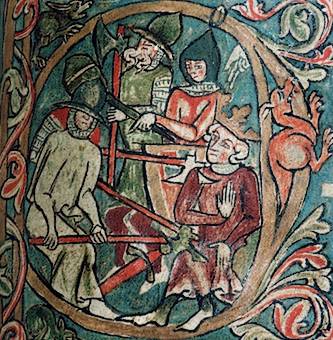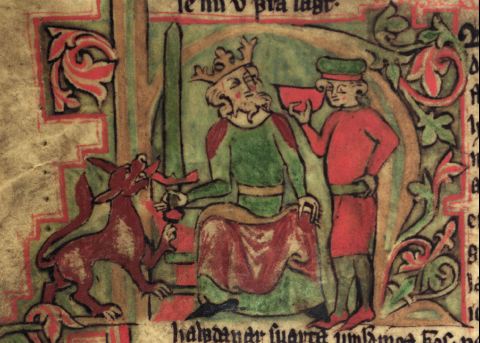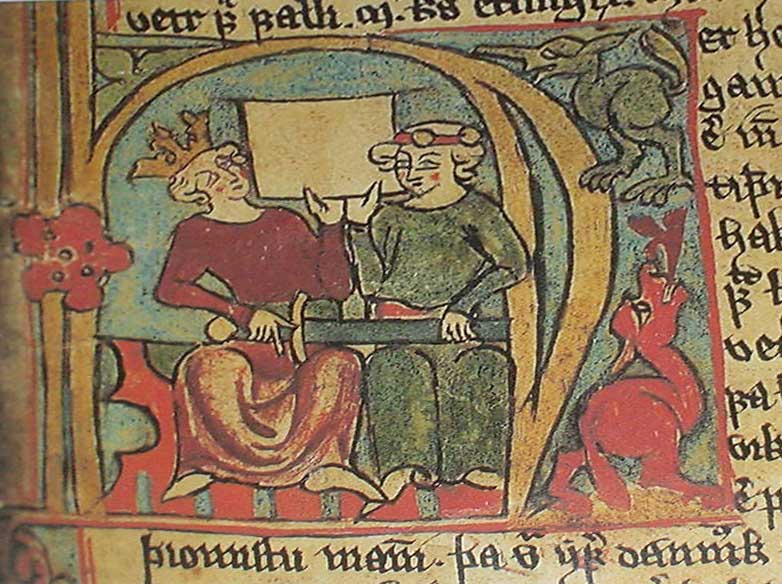


 |
 |
 |
- January 24 & 26: Early medieval Europe: the wheres & whens
please read
Barbara Rosenwein, Short History of the Middle Ages, pp. 21-218 [only ca. ½ is text] on reserve at Uris Library
Jesse Byock, Viking Age Iceland, cap. 1 on this website under Readings
no section this week
further recommended reading:
Gwyn Jones, A History of the Vikings, rev. edn, introduction (1984: 1-13) on reserve at Uris Library
What kinds of historical arguments can we make about early medieval Europe? How can we put them to the test?
- January 31 & February 2: Scandinavian prehistory
please read
Birgit & Peter Sawyer, Medieval Scandinavia: From Conversion to Reformation (1993), pp. 27-38 on this website under Readings
Else Roesdahl, The Vikings, pp. 25-29
Thomas DuBois, Nordic Religions, introduction & cap. 1
for section, please prepare:
Morten Axboe, “Danish Kings and Dendrochronology: Archaeological Insights into the Early History of the Danish State,” in After Empire: Towards an Ethnology of Europe’s Barbarians, ed. G. Ausenda (1995: 217-51; esp. 217-38) on reserve at Uris Library (also on this website under Readings)
further recommended reading:
Egil’s Saga , translators’ introductions to the Everyman edn (pp. vii-xxxi)
Gwyn Jones, A History of the Vikings, capp. 1-2 (1984: 17-54) on reserve at Uris Library
Knud J. Krogh, “The Royal Viking-Age Monuments at Jelling in the Light of Recent Archaeological Excavations: A Preliminary Report,” Acta Archaeologica 53 (1982): 182-216 on reserve at Uris Library
What types of sources give us most insight into early medieval Scandinavia? Does it make sense to speak of ‘early medieval Scandinavia’ as a unified entity?
- February 7 & 9: Sources & resources of Norse history
please read
Somerville & McDonald, The Viking Age, § 7 (pp. 42-74)
Sawyers, Medieval Scandinavia, pp. 1-26 on this website under Readings
Else Roesdahl, The Vikings, pp. 1-22, 168-84
for section, please prepare:
Baruch Fischhoff, “For those Condemned to Study the Past,” in Judgment under Uncertainty, ed. D. Kahneman, P. Slovic & A. Tversky (1982: 335-51) on reserve at Uris Library (also on this website under Readings)
John L. Gaddis, The Landscape of History, cap. 3 (2002: 35-52) on reserve at Uris Library (also on this website under Readings)
further recommended reading:
Somerville & McDonald, The Viking Age, introduction (pp. xiii-xvii)
Marc Bloch, The Historian’s Craft, tr. Peter Putnam (1953) on reserve at Uris Library
What are some strengths and weaknesses of various types of sources for early medieval Scandinavia? How do the medieval sources shape what we can know about the past?
- February 14 & 16: Scandinavian society i: traditions & constraints
please read
Somerville & McDonald, The Viking Age, §§ 1-3, 5-6, 28-29 (pp. 2-28, 38-40, 146-57)
Roesdahl, Vikings, pp. 30-63
Byock , Iceland , capp. 2-3
DuBois, Religions, cap. 5
for section, please prepare:
Consider Rígsþula (Somerville & McDonald, The Viking Age, § 3, pp. 18-28) as social history: what is its message? does it historicise social structure?
further recommended reading:
Henri Pirenne, extracts (from Medieval Cities & Mohammed and Charlemagne), rpt. in The Pirenne Thesis, ed. A.F. Havighurst (1958: 11-27) on reserve at Uris Library
To what extent was traditional Scandinavian society insular & inwards-looking? What broader contexts was it integrated into?
- February 21 & 23: Scandinavian society ii: change & innovations
please read
R.I. Page, Chronicles of the Vikings (1995), cap. 6 (pp. 139-49) on this website under Readings
Somerville & McDonald, The Viking Age, §§ 21-22, 33-37 (pp. 126-33, 194-201)
Egil’s Saga , capp. 1-22 (pp. 1-31 in the Everyman edn)
Roesdahl, Vikings, pp. 64-107
Byock , Iceland , capp. 4-5
for section, please prepare:
Judith Jesch, Women in the Viking Age, cap. 2 (1991: 42-74) on reserve at Uris Library (also on this website under Readings)
Consider the roles of women in the changing Scandinavian society of the early Viking Age. How did they contribute to such changes? How were they affected?
further recommended reading:
Richard Abels, Alfred the Great, extract on kingship (1998: 246-84) on reserve at Uris Library
What constituted power in Scandinavia? Who wielded it? How did the emergence of new technologies (material & political) in the Viking Age affect its structures?
- February 28 & March 1: ‘From the fury of the Norsemen, deliver us, o Lord’
please read
Somerville & McDonald, The Viking Age, §§ 30-31a, 31d-32, 38-47, 50 (pp. 160-63, 168-91, 202-61, 269-72)
Roesdahl, Vikings, pp. 187-203, 221-26, 233-39
Egil, capp. 23-35 (pp. 31-50)
for section, please prepare:
this week's readings from Somerville & McDonald, The Viking Age, esp. Alcuin’s letter to Æthelred (§ 41, pp. 232-34)
Ermentarius, “The Wandering Relics of St. Philibert,” in David Herlihy’s The History of Feudalism (1970: 8-13) on reserve at Uris Library
further recommended reading:
Roger Collins, Early Medieval Europe, 300-1000, cap. 19 (1999: 364-89) on reserve at Uris Library
Peter Sawyer, Kings and Vikings, cap. 6 (1982: 78-97) on reserve at Uris Library
F. Donald Logan, The Vikings in History, 3rd edn, cap. 2 (2005: 21-42) on reserve at Uris Library
The First Viking Age in the West (9th century): an unprecedented calamity or a case of mass hysteria?
- March 6 & 8: Honourable men: a viking social order
please read
Somerville & McDonald, The Viking Age, §§ 25-27, 79, 83 (pp. 136-45, 370-72, 393-95)
Byock , Iceland , capp. 6-7, 9-10, 17
for section, please prepare:
“The [Norse] possessed a well-developed vocabulary for describing soc[iety] and politic[s]” (Byock, Iceland, p. 118). What were its key terms & concepts? Use the readings to think about how these terms & concepts might have played out in social action.
further recommended reading:
Marc Bloch, Feudal Society, part 4, capp. 9-17 (1961: 1.123-238) on reserve at Uris Library
Was viking society violent? cruel? just? courteous? sentimental? Were its structures rigid or loose? What mechanisms allowed people to get along & kept the social fabric intact?
- March 13 & 15: Varangians: Scandinavians in the East
please read
Somerville & McDonald, The Viking Age, §§ 19a, 58-65 (pp. 106-10, 302-27)
Roesdahl, Vikings, pp. 277-92
DuBois, Religions, cap. 6
Martina Stein-Wilkeshuis, “A Viking-Age Treaty between Constantinople and Northern Merchants,” Scando-Slavica 37 (1991): 35-47 on reserve at Uris Library
for section, please prepare:
this week's readings from Somerville & McDonald, The Viking Age, esp. Ibn Fadhlan's account (§§ 19a & 62, pp. 106-10, 316-18; also available in H.M. Smyser's older translation, in Franciplegius, ed. J.B. Bessinger, Jr. & R.P. Creed [1965: 92-119] on reserve at Uris Library).
further recommended reading:
T. Noonan, “The Vikings & Russia: Some New Directions & Approaches to an Old Problem,” in Social Approaches to Viking Studies, ed. R. Samson (1991: 201-6) on reserve at Uris Library
What are the major distinctions between the Viking Age (in the West) and the ‘Varangian Age’ (in the East)? How did topography, technology and the peoples encountered differ?
- March 27 & 29: Scandinavian religion i: pagans & Christians
please read
Somerville & McDonald, The Viking Age, §§ 8-9, 11-19 (pp. 76-90, 92-114)
Eirik the Red's Saga, capp. 1-6 (in The Vinland Sagas, pp. 25-38)
Roesdahl, Vikings, pp. 147-67
DuBois, Religions, capp. 2-3
for section, please prepare:
Review the range of sources available to us for learning about Norse religions. Consider what we can get out of such sources & what their limitations are.
further recommended reading:
J.M. Wallace-Hadrill, “The Vikings in Francia,” Stenton Lecture 1975 (1976: 3-19) on reserve at Uris Library
Roberta Frank, “Viking Atrocity and Skaldic Verse: The Rite of the Blood-Eagle,” English Historical Review 99:391 (1984): 332-43 available via JSTOR, connect via the Cornell Library Catalogue
What aspects (beliefs, values, rituals, etc.) of viking pre-Christian religion do our sources reveal? Which of these aspects are they most likely to depict reliably?
- April 3 & 5: Scandinavian religion ii: Red Þórr & White Christ
Guest lecture (5 April): Joel Anderson (Medieval Studies), medieval and Icelandic manuscripts
please read
Somerville & McDonald, The Viking Age, §§ 84-88, 90-93 (pp. 398-419, 420-31)
Eirik the Red, capp. 7-14 (in Vinland, pp. 38-50)
Byock , Iceland , capp. 16, 18
for section, please prepare:
Julian D. Richards, “Pagans and Christians at a Frontier: Viking Burial in the Danelaw,” in The Cross Goes North, ed. Martin Carver (2003: 383-95) on reserve at Uris Library
further recommended reading:
Martin Biddle and Birthe Kjølbye-Biddle, “Repton and the ‘Great Heathen Army,’ 873-4,” in Vikings and the Danelaw, ed. James Graham-Campbell et al. (2001: 45-96) on reserve at Uris Library
Why did Norsemen convert to Christianity? Was the advance of Christianity inevitable? Was Christianisation a sharp discontinuity or a smooth transition from paganism?
- April 10 & 12: ‘He fled not at Uppsala …’
please read
Somerville & McDonald, The Viking Age, §§ 48-49, 51-54 (pp. 262-69, 274-92)
Egil, capp. 36-65 (pp. 51-123)
Roesdahl, Vikings, pp. 203-20, 226-29, 239-50
Byock , Iceland , capp. 11-13
for section (April 7 & 8), please prepare:
Anglo-Saxon Chronicle , tr. D. Whitelock et al., entries for 973-1017 (1961: 76-97) on reserve at Uris Library
further recommended reading:
Peter Sawyer, “Ethelred II, Olaf Tryggvason, and the Conversion of Norway,” Scandinavian Studies 59 (1987): 299-307 on reserve at Uris Library
How did viking activity in the West during the 10th century differ from what had characterised the early phases of the Viking Age? What caused these differences?
- April 17 & 19: The Norse Atlantic: Iceland, Greenland and beyond
please read
Somerville & McDonald, The Viking Age, §§ 66-70, 72-74 (pp. 330-43, 346-50)
Egil, capp. 66-85 (pp. 114-70)
Saga of the Greenlanders (in Vinland, pp. 1-21)
Roesdahl, Vikings, pp. 262-76
for section, please prepare:
Adolf Friðriksson & Orri Vésteinsson, “Creating a Past: A Historiography of the Settlement of Iceland,” in Contact, Continuity, and Collapse, ed. J.H. Barrett (2003: 139-61) on reserve at Uris Library (also on this website under Readings)
further recommended reading:
D. Odess et al., “Skraeling: First Peoples of Helluland, Markland, & Vinland,” and T.H. McGovern, “The Demise of Norse Greenland,” in Vikings: The North Atlantic Saga (2000: 193-207, 327-39) on reserve at Uris Library
What might have attracted Norsemen to explore & settle the North Atlantic? What reasons do the primary sources suggest? Why did some colonies fail?
please read
Roesdahl, Vikings, pp. 108-46, 229-32; cf.
Sawyers, Medieval Scandinavia, cap. 7 on this website under Readings
Byock, Iceland, cap. 14
Somerville & McDonald, The Viking Age, §§ 57, 97-102 (pp. 295-300, 444-89)
Roesdahl, Vikings, pp. 250-61
Sawyers, Medieval Scandinavia, pp. 57-79 on this website under Readings
Byock, Iceland, cap. 19
for section, please prepare:
Snorri Sturluson, “Saga of King Harald Hardrade,” in Heimskringla, capp. 76-101 (cf. Somerville & McDonald, The Viking Age, § 100, pp. 471-79)
1. Consider the readings for this week; is the notion of ‘urban viking’ a contradiction in terms? If so, why? If not, how?
2. Are the ‘Norse empires’ of the 11thC comparable to earlier Norse polities? Should we consider Cnut, Haraldr harðráði and William the Conqueror vikings?
further recommended reading:
R.S. Lopez, “Of Towns and Trade,” in Life and Thought in the Early Middle Ages, ed. R.S. Hoyt (1967: 30-50) on reserve at Uris Library
Gwyn Jones, A History of the Vikings, part 4, capp. 2-3 (1984: 354-415) on reserve at Uris Library
Where did early medieval towns emerge? How did they come into being? Who lived in them? What determined if a town would flourish or die? Were there any viking towns?
please read
Egil , capp. 86-87 (pp. 170-71)
Sawyers, Medieval Scandinavia, cap. 10 on this website under Readings
Byock , Iceland , capp. 8, 15
DuBois, Religions, cap. 8 & epilogue
for section, please prepare:
Review questions for the final exam. (Please let me know ahead of time whether you have any questions; sections will only meet if there is call for them.)
further recommended reading:
Guy Halsall, “Playing by whose Rules? A Further Look at Viking Atrocity in the Ninth Century,” Medieval History 2:2 (1992): 2-12 on reserve at Uris Library
M.T. Clanchy, From Memory to Written Record, introduction & cap. 1 (1993: 1-43) on reserve at Uris Library
What were (& are) the interests of the people who preserve[d] Viking Age history, and how do these effect our perception of the period? Why are you interested?
|
return to HIS 3200 syllabus
Oren Falk, Associate Professor
Department of History, Cornell University
Page last updated on: 25 April, 2012